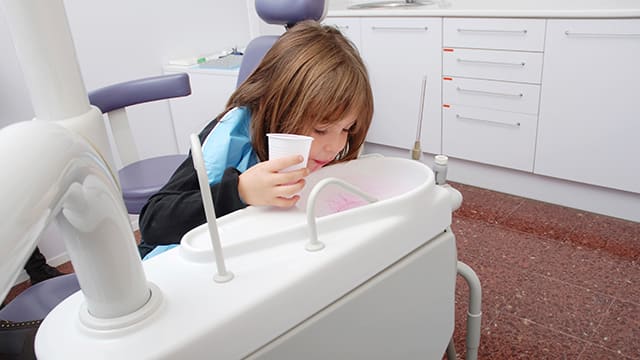If not stopped, plaque, or biofilm, plays havoc with your mouth in an ever-evolving manner:
- Plaque germs combine with sugar to produce acids in your mouth.
- If allowed to accumulate, the acids gradually damage tooth enamel and lead to cavities.
- If you don't treat the cavities, decay worsens over time. And more advanced tooth decay stages require more extensive treatments.
If plaque gets a toehold, be aware of the various stages of tooth decay. Even better, learn how you can join your dentist and hygienist in stopping plaque and tooth decay.
First Signs of Tooth Decay
When tooth decay first develops, it can look like a brown or white spot on the tooth. This discolouration occurs when the enamel softens.
Unfortunately, since early tooth decay may not present any symptoms, it can only be detected during a dental check-up. That's why it's important to schedule regular dentist visits.
At this early stage, there's still a chance tooth decay can be stopped or even reversed before you develop a cavity. To accomplish this, your dentist may recommend treatments to:
- Make the tooth enamel stronger with a product such as topical fluoride.
Tooth Decay Stages
If you don't seek treatment for tooth decay promptly, you could experience stages that require more intensive dental work, increased sensitivity, pain, and worse.
However, depending on your stage of tooth decay, there might be treatments available.
Cavity Stages: If early-stage tooth decay isn't treated, the softened enamel will start to break down, resulting in a cavity.
At this point, it might not be possible to reverse the damage to the tooth. However, your dentist can help you prevent further decay with various treatments.
If you think you have a cavity, see your dentist right away. Treatment depends on the size and location of the cavity.
Your dentist might recommend a filling, which involves removing the decayed portion of the tooth and restoring the area with a filling material. Larger cavities could require a crown, a tooth-coloured cap that completely covers the teeth.
Dentin Decay Stages: If left untreated, your cavity can spread deeper into the tooth. It might reach the dentin, the sensitive tooth layer beneath the enamel.
You don't want the dentin decay to spread even further. If it does, dentin decay can reach the pulp, the location of your tooth's nerves, and blood vessels.
If the decay advances, you may experience the following symptoms in the affected teeth:
- Sensitivity or even pain when you consume sweet, hot or cold foods and drinks
- Toothaches or pain when you bite down
- Visible as holes or pits as the decay worsens
Complications of Untreated Decay
If untreated decay symptoms are bad, the resulting complications could require surgery or other invasive treatments.
If untreated, severe tooth decay can result in an infection. A pocket of pus, or abscess, might develop at the tip of the tooth root.Symptoms of tooth abscesses can include pain, swelling and fever. If left untreated, the infection can spread to the surrounding areas, including the jawbone.
Tooth loss is another possible complication of untreated decay.
Preventing Tooth Decay
Fortunately, you can reduce your risk of tooth decay with some lifestyle actions.
Start an oral hygiene routine: Caring for your teeth requires only five minutes a day.
- Brush your teeth at least twice a day with fluoride toothpaste.
- Floss at least once a day.
- Rinse with a fluoride mouthwash, especially if your dentist recommends it.
Eat a tooth-healthy diet: Food strategies can make a big difference in your oral health. Eat fruits and vegetables, especially those of the fibre-rich variety, to get healthy saliva flowing.
- Consume dairy products, such as cheese, yoghurt, and milk. Dairy is another saliva generator that supplies vitamins and minerals needed for tooth enamel.
- Avoid sugary foods, such as cake and cookies. Can't avoid them? Then eat them during meals when your mouth makes more saliva, which helps to reduce acid. Also, brush after eating these foods.
- Avoid starchy foods, such as chips, which can cling to teeth and contribute to plaque build-up. Can't avoid them? You know what to do: brush after eating them.
Ask your dentist for more information about tooth-healthy food choices.
Have regular dental check-ups: As you've read, these visits are crucial so your dentist can identify early-stage tooth decay and treat it before it gets worse.
However, if you suspect you might have a cavity now, see your dentist immediately. Oral care in the first stage of tooth decay is essential to your overall health.













